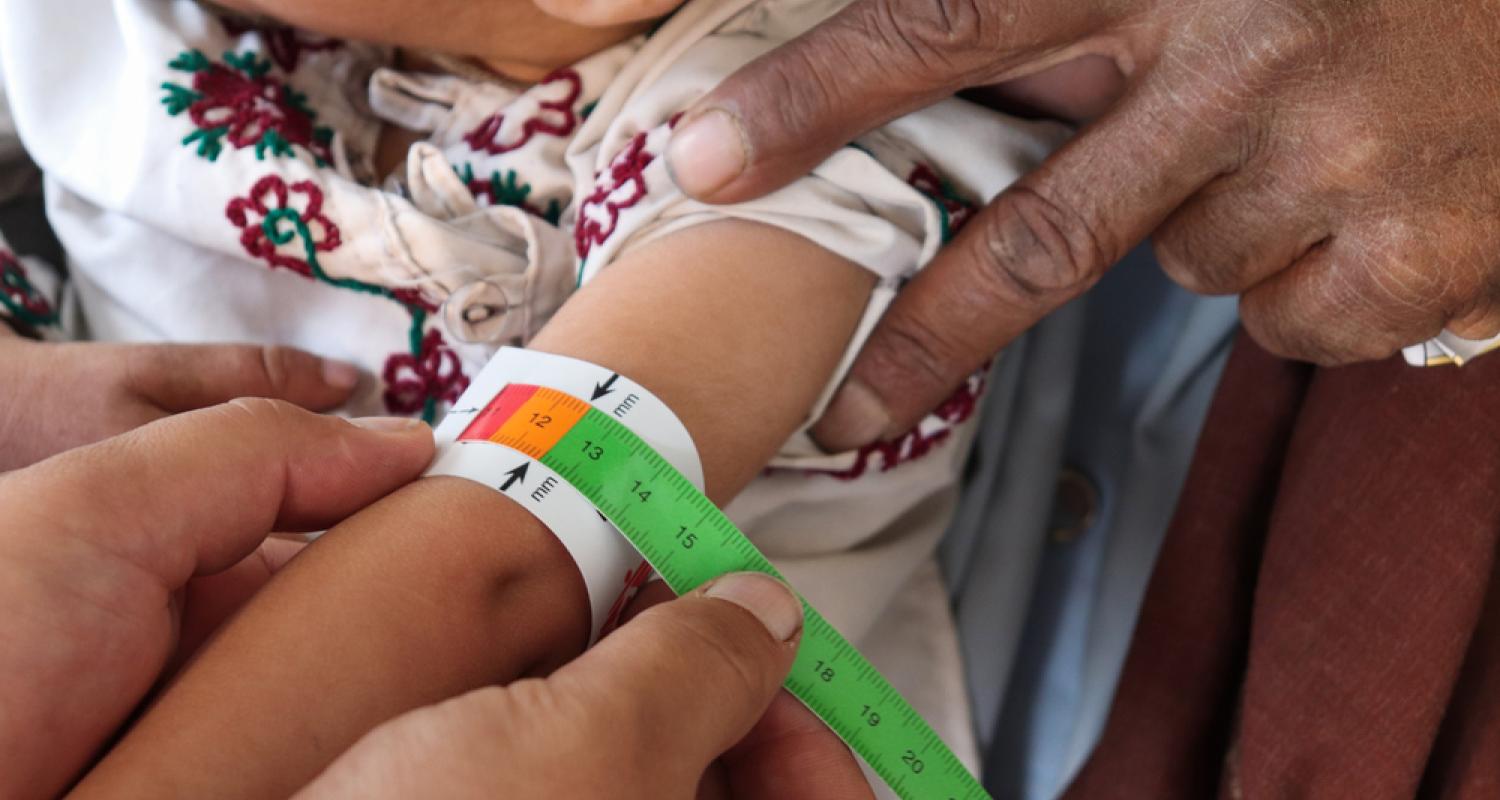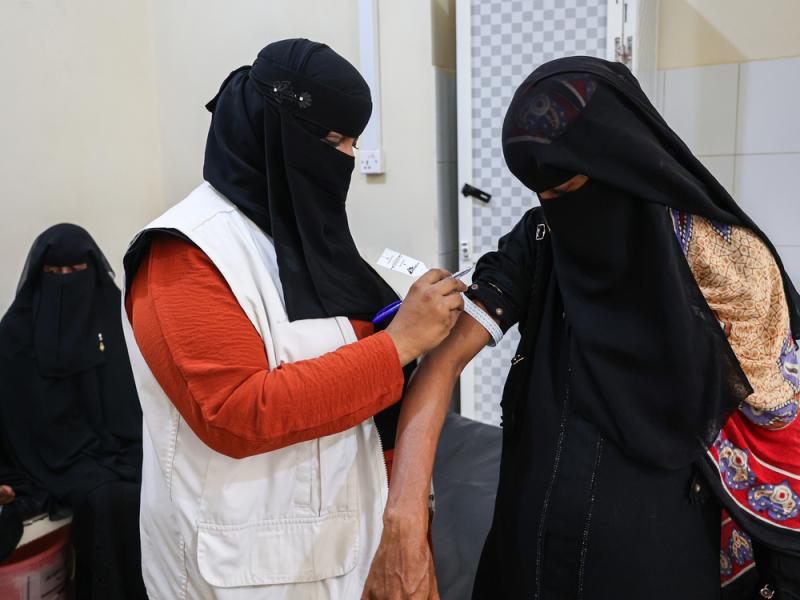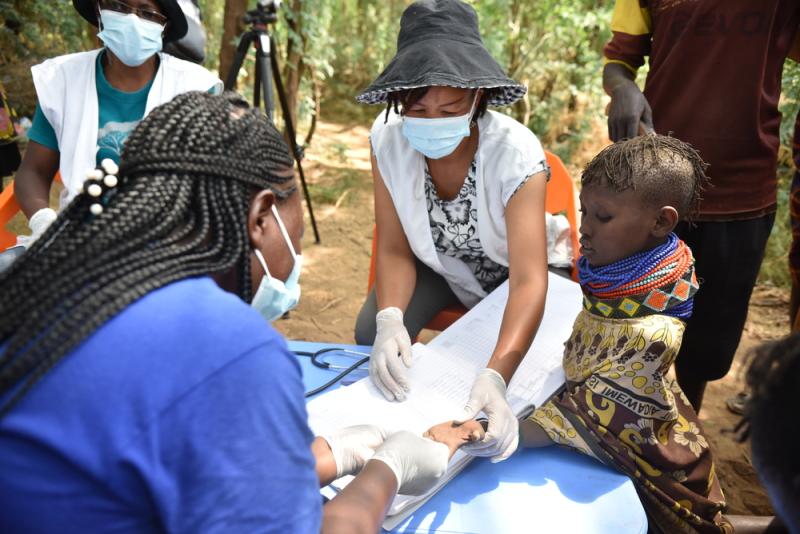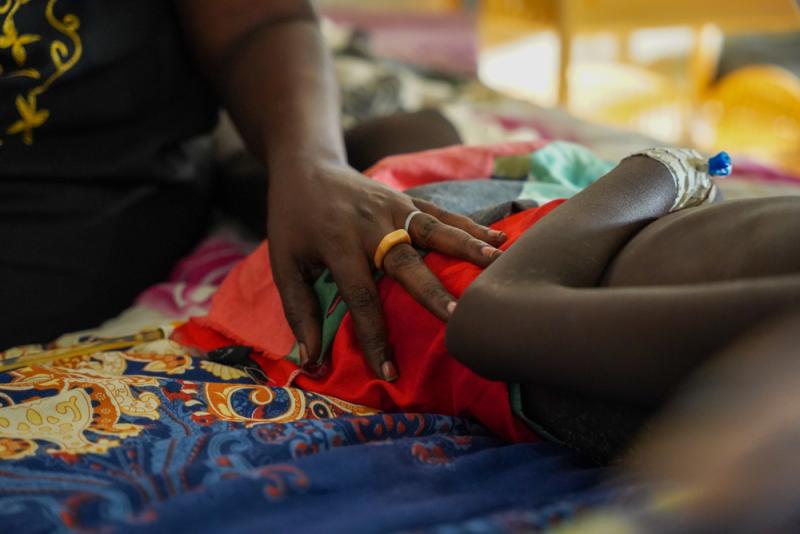Malnutrition on the rise
In some parts of the world, hunger is not just a feeling of discomfort between meals; it's a constant, looming threat that can have devastating consequences. Malnutrition, the result of not consuming enough nutrients, is a significant issue in many regions and populations, including Afghanistan, Yemen, Nigeria, and South Sudan.
For years, Doctors Without Borders / Médecins Sans Frontières (MSF) has been at the forefront of the battle against malnutrition in these regions, working tirelessly alongside local authorities to mitigate its effects. However, with the looming threat of malnutrition becoming a more widespread issue in the future, the fight to combat this scourge has become more urgent than ever before.
Latest update
Underlying causes of malnutrition
According to the latest data from the United Nations, the number of people experiencing chronic undernourishment has been increasing since 2014, reaching 828 million in 2021.
Globally, 11.7 per cent of the population is suffering from severe food insecurity. Around the world, the number of people unable to afford a healthy diet also increased by 112 million--to almost 3.1 billion. This indicates that more people cannot access safe, nutritious, and sufficient food.
An estimated 45 million children under five years of age suffer from wasting, 149 million have stunted growth and development due to a chronic lack of nutritious food in their diets, and 39 million are affected by being overweight.

There are several reasons why malnutrition may be on the rise:
- Displacement and conflict: Conflict and displacement can disrupt food systems and limit access to food, especially in areas with high food insecurity.
- Climate change: Droughts, floods, and other weather events can disrupt food production and lead to food shortages.
- Economic downturns: Economic downturns can result in rising food prices and reduced access to food, particularly for vulnerable populations.
- COVID-19 pandemic: The COVID-19 pandemic has led to job losses and economic instability, which has made it more difficult for many people to afford food.
- Poor dietary choices: In some cases, malnutrition may be caused by poor dietary choices rather than a lack of access to food. This can be particularly true in developed countries where high-calorie, low-nutrient foods are often more affordable and accessible than healthier options.
With increasing insecurity, climate change, and global inflation of food prices in a post-pandemic world, we can only imagine this crisis getting worse.Dr. Simba Tirima, Nigeria Country Rep.
- Yemen
Doctors Without Borders works in 13 of Yemen’s 21 governorates. In most of our facilities, we have witnessed a concerning surge in the number of malnourished children with medical complications. This has pushed bed occupancy rates well above 100 per cent capacity across our inpatient therapeutic feeding centres (ITFCs) . To cope with the increased numbers of malnutrition cases, and to reduce morbidity and mortality among the most vulnerable, our teams are scaling up capacity across projects in the ITFCs and other departments, increasing our support to general healthcare centres, and increasing health promotion activities.
Our teams in Amran governorate working in Al-Salam-Khamer Hospital have seen a steady increase in the number of patients with severe acute malnutrition (SAM) since the end of May 2022. The bed occupancy rate reached 39.6 per cent in ITFC by September 2022.
At the same time, there was a more than 20 per cent increase in the number of emergency consultations. Between January and September 2022, 31 patients with SAM died after admission. Most arrived too late and had medical complications that were too severe to be treated.
Many of the people who were admitted to the Doctors Without Borders-supported Al-Salam Hospital with SAM travelled from surrounding areas where the basic healthcare facilities were only partially functioning. A similar trend was observed in the Al-Hudaydah governorate.
Our team in the emergency department of Ad-Dahi Hospital received 1,902 children suffering from malnutrition with complications, between January and October 2022.
From January to September, the Doctors Without Borders-supported ITFC at Abs Hospital admitted 2,087 children with malnutrition and associated medical complications, while more than 50 per cent of mothers in the maternity department in Abs Hospital were suffering from malnutrition.

Shohra Mohamed's grandson, Abdullah is a four-year-old suffering from malnutrition with complications. They have been to Abs Hospital several time, and he bean improving. The last time he was discharged was 20 days ago, then his situation worsened again.
"We prefer to come here as services are free of charge, we paid a lot over the years on his treatment and we can´t afford it anymore. Abdullah´s father is away. With his mother we try to feed him with what we have, we rarely can afford to give him milk. We go home with the treatment, and they advise us to follow a specific diet, which we can´t always do. We don’t have access to health centres that provide therapeutic food nearby.”
Yemen, 2022 © Jinane Saad/MSF
- Nigeria
Since January 2022, Doctors Without Borders teams, working in partnership with Nigerian health authorities in five northwestern states, have treated close to 100,000 children suffering from acute malnutrition in 34 outpatient facilities, and admitted about 17,000 children requiring hospital care in 10 inpatient centres.“We’re getting ready to treat up to 100,000 malnourished children in our nutrition programme in Katsina state alone, and have also expanded our response in Kebbi, Sokoto, Zamfara and Kano states,” said Michel-Olivier Lacharite, head of Doctors Without Borders emergency operations. “The hunger gap has begun, and the peak of malaria transmission, which would further deteriorate the health and nutritional status of children, is yet to come.”
In Zamfara state, one of the areas most affected by ongoing violence and banditry, we recorded a 64 percent increase in the numbers of severely malnourished children treated in the outpatient nutritional departments supported by Doctors Without Borders from January to August 2022 when compared to January to August 2021. Of the total screened children, almost every fourth was severely malnourished and in need of urgent medical care. Doctors Without Borders, in cooperation with the authorities, is immediately launching an emergency response in the area.
Doctors Without Borders’s nutritional surveys have also underlined the severity of the crisis, including in areas that are less affected by violence and insecurity.

Abdousalam Issa (4 months) and his mother Saadatou Saminoa (34) with a nurse. Niger, 2022. © Oliver Barth/MSF
In Mashi local government area, in Katsina state, Doctors Without Borders found a 27.4 per cent rate of global acute malnutrition and a 7.1 per cent rate of severe acute malnutrition in June, even though the community has been relatively spared from violence and forced displacement. These rates indicate a critical emergency.
In Katsina, the teams quickly had to increase their inpatient capacity from 100 to nearly 280 beds. Still, the influx of malnourished children was so significant that restricted admission criteria had to be introduced for some of the treatment centres.
In Kebbi, where Doctors Without Borders runs an inpatient and two outpatient facilities, about 1,500 malnourished children have been treated since March 2022.
- Madagascar
Doctors Without Borders first worked in Madagascar in 1987, and most recently returned in 2021 to tackle the malnutrition crisis in the south of the country.
Since March 2021, Doctors Without Borders emergency teams have been setting up more and more mobile clinics to deliver humanitarian and medical assistance in several districts across the region.
Today, Doctors Without Borders supports 29 local health facilities in the Ikongo district with nutritional care, providing therapeutic foods and training health staff to diagnose and treat malnutrition.
They have now begun distributing food and recently opened an inpatient therapeutic feeding centre in the hospital in the town of Ambovombe, in the Androy region.
Two consecutive cyclones hit southeast regions of the country in 2022, destroying all crops and leaving a trail of destruction. The cyclones affected almost the entire agricultural area in the southeastern Vatovavy, Fitovinany, Atsimo, and Atsinanana regions, including more than half of people’s food crops.

People waiting for medical consultations in Ifanirea health center. Ifanirea, Madagascar, January 2023. © MSF
“While communities in these areas already have very high rates of chronic malnutrition, the cyclones have tipped them over into an acute situation,” said Brian Willett, Doctors Without Borders head of mission in Madagascar. “Repeated climate shocks aggravate hardship for communities that have to build back every time.”
In fact, during nutritional screenings in November 2022, Doctors Without Borders found that nearly one in five children screened had moderate or severe malnutrition at the onset of the lean season, which typically lasts from September to April.
“Few humanitarian organizations work in the southeast and we are looking at scaling up our activities,” Willett said. “Many households tell us that despite careful rationing, their staple food stocks will be completely empty by February 2023. This is worrying as the crop production from this year’s season is expected to be low due to little rain at the beginning of the season. If yet another cyclone was to hit this season, it would transform this already dire situation into a catastrophe of significant scale.”
Currently, Doctors Without Borders is supporting 24 health facilities in hard-to-reach places in southeast Madagascar, and treating patients for malnutrition in five health centres in the Ikongo district of the Fitovinany region. As of early January 2023, 2,072 children under the age of five were being treated for severe acute malnutrition. Nearly half of these children were admitted to Doctors Without Borders' nutritional programs. This number is expected to rise over the coming months due to a lack of food and the peak of the malaria season—a disease that can exacerbate malnutrition.
- Somalia
Doctors Without Borders teams have been increasing our nutrition programmes to meet the significant increase of acutely malnourished children in Baidoa city, in South West state of Somalia.
The area is badly affected by an unrelenting drought, the worst in 40 years, amidst a decades-long conflict, continuing insecurity, and an inadequate humanitarian response.
Between January and August 2022, Doctors Without Borders screened over 206,000 children across Somalia for malnutrition, finding 23,000 among them malnourished. Some are arriving at Doctors Without Borders nutrition programmes in a critical state.
In Baidoa, where Doctors Without Borders run 20 mobile nutrition clinics and 32 nutrition monitoring sites, medical teams treated more than 12,000 malnourished children in the first eight months of 2022. In August 2022, in just one week, Doctors Without Borders screened 955 children and admitted 761 to our nutrition programme, most of them from newly displaced families.
We continue to see around 500 acutely malnourished children a week.

Doctors Without Borders Physician Doctor Ahmed Ilyas examining baby Saidya at Doctors Without Borders-supported BRH in Baidoa, SW State, Somalia. 2022. © Dahir Abdullahi/MSF
Multi-seasonal drought has worsened the nutrition situation of people, but the protracted humanitarian crisis is continually driven by multiple factors. This includes Baidoa’s healthcare system, which is struggling to provide for the additional hundreds of thousands of displaced people.
Long-standing conflict, an inadequate humanitarian response, climate impacts, as well as rising food and fuel prices, also contribute to the precarious situation for people.
Malnutrition is exacerbated by infectious diseases, as a malnourished person is more susceptible to infection, and infection contributes to malnutrition.
- Ethiopia
Doctors Without Borders has been witnessing alarming indications of a deadly and escalating nutrition crisis in Ethiopia’s Afar region, requiring an urgent scale-up of the humanitarian response.
In Afar, in the country’s northeast, hundreds of thousands of people have fled from recent conflict only to find themselves grappling alongside host communities with drought, hunger and a staggering lack of access to healthcare and clean water.
The impact of these conditions is apparent among the patients in Dupti hospital, which serves a population of more than 1.1 million people, including hundreds of thousands of displaced people. At the hospital, nearly two-thirds of malnourished children requiring hospitalisation come from displaced families, driving up admission rates.
Since April, Doctors Without Borders have been increasing our support to Dupti hospital. In 2022, the number of severely malnourished children admitted to the facility has already exceeded the previous year’s baseline by a factor of three to four. Patient mortality rates are staggeringly high, exceeding 20 per cent in some weeks. Many children are dying and more than two-thirds of those patients admitted died within 48 hours of admission.
“What scares us most at this point is that we are only beginning to see the very tip of the iceberg, and already it is overwhelming,” said Raphael Veicht, Doctors Without Borders Emergency Coordinator in Addis Ababa, Ethiopia. “In Dupti Hospital, which is the only functional referral hospital in all of Afar region, we are seeing children arrive after incredibly long and difficult journeys.”
“Far too many of them are dying within 48 hours because they are too sick and too malnourished to have a fighting chance at survival,” said Veicht.
“To even begin to get control of this, a major scale of humanitarian assistance is urgently needed for displaced people and vulnerable host communities,” said Veicht. “Food security, basic healthcare, nutrition and water need to be the key points of focus.”

Mayram (26) holds her three month old son Ali, in the intensive Inpatient Therapeutic Feeding Center (ITFC) ward in Dupti hospital , Afar region. Ali was admitted with severe acute malnutrition. Ethiopia, 2022. © Njiiri Karago/MSF
Damaged, destroyed, abandoned or under-resourced, it is reported that only 20 per cent of health structures in the Afar region are functional. At Dupti hospital, more than 80 per cent of malnourished children admitted for care have had no previous access to healthcare before arriving at the referral hospital.
Our team opened 14 additional beds in temporary structures, but these are also fully occupied and medical staff struggle to provide the level of care children need in this overcrowded facility. And recently, even the regular paediatric ward has become overwhelmed, with more than double the number of patients than beds.
“In two days alone, we saw 41 children admitted to the paediatric ward with severe stomach infections because people are forced to drink from muddy puddles,” said Veicht.
Doctors Without Borders has agreed with the Ethiopian Ministry of Health to increase the hospital’s paediatric, in-patient feeding and emergency departments’ capacity. This includes the rapid construction of new buildings, and to support sanitation and the establishment of a reliable water source. In parallel, we plan to open five outpatient feeding programmes in the most critically needed areas, but far more is needed to stave off a looming crisis.
- Kenya
In northeast Kenya, an ongoing drought is raging following three consecutive seasons of failed rains, making an already dire food insecurity situation worse. Marsabit County is now reporting high or above-usual rates of acute malnutrition.
In February 2022, Doctors Without Borders carried out an assessment in five sub-counties of Marsabit. North Horr sub-county, specifically in Illeret, has the worst food insecurity and the highest number of malnourished children. A mass screening done by UNICEF in Marsabit, also in February, showed a critical global acute malnutrition rate of 23 per cent.
Eleven children who were patients in the malnourishment programme died between mid-February and mid-March 2022.

Doctors Without Borders clinician, nurse and nutritionist attend to nine-month old Egura Arbollo during a ward round in Illeret Health Center. She was admitted with severe acute malnutrition with severe dehydration from diarrhoea, vomiting and fever. April, 2022. © MSF/Lucy Makori
The Ministry of Health and other organisations conducted outreach activities to support the integrated management of acute malnutrition in some sub-counties. These activities could not be sustained, reducing the identification of malnourished children and follow-ups in the communities.
“More funding and coordination are needed to be able to meet people's critical needs and address malnutrition,” says Edi Atte, Doctors Without Borders country director in Kenya. “Mobile outreach needs to offer regular nutrition assessment and support. In the past, logistical and human resource challenges meant outreach clinics were held only once or twice a month, undoing the treatment progress of malnourished children and follow-ups.”
Doctors Without Borders has been working with the Ministry of Health and other organisations to strengthen the medical component of nutrition management activities in Illeret. Doctors Without Borders teams support the screening, diagnosis and management of acute malnourished children. Our approach of active case finding and surveillance has increased the number of children who have access to this care.
“Since we started our intervention in March 2022, there has been an increase in admissions of children with acute malnutrition and children not responding to treatment,” says Edi Atte. “We enhanced referrals to the stabilisation centre in Illeret. This has saved lives.”
Doctors Without Borders has also assisted in adapting the inpatient department of Illeret Health Centre to a 10-bed inpatient therapeutic feeding centre. Mothers in the feeding centre also receive three meals a day to enhance their lactation.
It’s now raining in the region and food distribution is happening. However, there is still a critical need for consistent, quality and adequate food distribution for households. Long-term solutions must also be found to help people access to water, an issue which continues to impact children’s health.
- South Sudan
Four consecutive years of flooding have left about two-thirds of the country under water, with Jonglei, Northern Bahr El Ghazal, Upper Nile, Unity, Warrap, Western Equatoria, and Lakes States in South Sudan and Abyei Special Administrative Area, all experiencing severe floods in the past few months.
The floods have displaced hundreds of thousands of people, killed millions of animals, and destroyed thousands of acres of crops, compounding an escalating food security crisis in the country. The UN World Food Programme estimates that more than 75 per cent of people in South Sudan are in need of food assistance.

Aerial view of a flooded village near Old Fangak, South Sudan. The fourth year of consecutive flooding has devastated the area. June 2022. © Florence Miettaux
Our teams are witnessing a worrying increase in rates of moderate to severe acute malnutrition. Between January to September this year, more than 4,200 children were treated for malnutrition across our medical facilities in South Sudan.
With nowhere else to go, tens of thousands of people have resorted to living in displacement camps. The lack of shelter, safe drinking water, and sanitation facilities in the camps are resulting in outbreaks of infectious and water-borne diseases and other health risks. The result has been a humanitarian disaster for people who already endure far too many of them.
Although the country is now entering the dry season, there appears to be no reprieve on the horizon. The devastating impact of the loss of crops and livestock are expected to result in rising rates of malnutrition.
- Afghanistan
Since 2021, Doctors Without Borders has seen very high numbers of patients in our Inpatient Therapeutic Feeding Centres (ITFCs) and Ambulatory Therapeutic Feeding Centre (ATFC) in Helmand, Herat and Kandahar.
Kandahar
In Kandhar, Doctors Without Borders also runs nutrition activities in Kandahar, with a focus on children who suffer from severe acute malnutrition (SAM) and are 6 to 59 months old. From January to September 2022, 31,544 children were screened in the Doctors Without Borders Therapeutic Feeding Programme in Kandahar. Out of everyone screened until the end of September 2022, 5,224 were enrolled in the ATFC, and 426 were admitted to the ITFC.
Also in September 2022, 488 patients were enrolled in the ATFC, and 110 children were admitted to the ITFC; this represents 25.8 per cent of all admitted patients to the ITFC in 2022.

Women sitting in the waiting area outside Doctors Without Borders' Ambulatory Therapeutic Feeding Centre (ATFC) in Kandahar, Afghanistan. November 2022. © Tasal Khogyani/MSF
Lashkar Gah, Helmand
In Doctors Without Borders-supported Boost Hospital in Lashkar Gah, we continue to see severe and acutely malnourished children admitted to the ITFC.
Herat
The Doctors Without Borders ITFC at Herat Regional Hospital (HRH) treats severely malnourished children who have an additional medical complication. In 2022, about one-third of patients admitted were under six months old.
At the Kahdestan clinic, we provide outpatient treatment for children and for pregnant and lactating women.
Kabul
Between February 2022 and July 2022, Doctors Without Borders undertook renovation work on the paediatric department of the Ministry of Higher Education Maiwand Teaching Hospital, and on July 2022 established a new 34-bed ITFC there.
Khost
Khost Maternity Hospital provides maternal healthcare to pregnant women experiencing complications, as well as neonatal care. In September 2022, we screened 1,770 pregnant women for malnutrition, of whom over 15 per cent presented with moderate acute malnutrition (MAM), and fewer than 1 per cent with SAM. These women received treatment in KMH as well.
What is Doctors Without Borders doing to address malnutrition?
Doctors Without Borders has been responding to the malnutrition issue in several countries including Afghanistan, Yemen, Nigeria, South Sudan and Madagascar.
In many of our projects, we also respond to individual cases of malnutrition.
Quick facts about malnutrition
Doctors Without Borders screens a community for potential malnutrition by conducting nutritional assessments, and during almost all of our outpatient and inpatient services which are not dedicated specifically to nutrition and during other interventions. Our teams assess children by comparing their weight-for-height ratio to international WHO standards, and/or by measuring a child’s mid-upper-arm circumference (MUAC) using colour-coded paper bracelets. MUAC measurements are also simple enough to be used at a village level by community health workers.
The widespread use of ready-to-use therapeutic food (RUTF), that can be stored long-term without refrigeration and contains a specific balance of nutrients, allows us to more effectively fight against malnutrition. RUTF can be either a paste, much like peanut butter, or in a biscuit form. The majority of children can be treated at home by their family, with follow-up appointments at a clinic. This strategy can result in cure rates of over 90 per cent, and can reduce referral to inpatient care.
In some regions, our teams run malnutrition prevention projects to stop children from falling ill, especially after a yearly “hunger gap”. Doctors Without Borders starts working and sets up outpatient clinics months before malnutrition cases peak at the start of the rainy season. In areas where malnutrition is likely to become severe, our teams take a preventative approach by distributing a nutritious supplement to at-risk children across Africa and Asia and making sure other disease prevention initiatives, like vaccinations and malaria chemoprophylaxis, are implemented.








